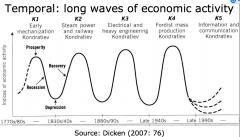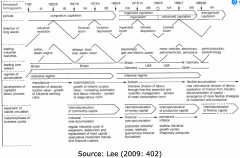![]()
![]()
![]()
Use LEFT and RIGHT arrow keys to navigate between flashcards;
Use UP and DOWN arrow keys to flip the card;
H to show hint;
A reads text to speech;
12 Cards in this Set
- Front
- Back
|
Characteristics of Capitalism 1
|
Endless accumulation (Wallerstein, 2004):
- Capitalism only exists when we give priority to the endless accumulation of capital - "people andfirms are accumulating capital in orderto accumulate still more capital" this process is continuous and endless |
|
|
Characteristics of Captialism 2
|

Uneven Development
|
|
|
Economic Restructuring and Technological Change: Restructuring
|
Restructuring= underlying shift in organisation of an economy
|
|
|
Technological Change
|
“a fundamental force inshaping the patterns oftransformation of the economy” (Dicken, 2007: 73)
|
|
|
Economic Restructuring And Technological Change 2
|
- 'Swarming' together of key innovations
- Basis for the emergence of new industries and technologies - Driven by innovation for competitive advantage - Older industries and industrial regions can suffer disinvestment |
|
|
Economic Restructuring/Tech Change 3
|
- Long waves of economic activity can be linked to 'layers' of investment
- New industries develop along an economic landscape that is inherited from the past - Decline of 'old' industrial regions and rise of new ones |
|
|
Economic Restructuring and 'Long' Waves
|

|
|
|
Characteristics of the world economy since 1950
|
- Increased volatility of aggregate economic growth
- Integration of national boundaries across markets, finance, technologies, and nation-states in a way not witnessed in the past (Daniels, 2008) - Increasing importance and influence of multinational corporations |
|
|
Why did Scotland miss out on the Fourth Kondrateiff
|
- continued belief in the profitability of traditional sectors
- Scotland not an attractive location for new light industries - Low incomes stifled consumer demand for products of new sectors - Lack of domestic investment in new sectors? |
|
|
Growing economic wealth in Scotland since 1950
|
- More people in employment, expansion of workforce (particularly female workforce)
- |
|
|
Growing Prosperity in Scotland since 1950
|
- More people in employment
- Growing employment in public administration, finance, distribution and catering industries - Expansion of welfare provision - Effect of regional policy from about 1960 to 1980 |
|
|
Summary
|
- Far reaching restructuring of the Scottish economy since about 1950
- Convergence with the rest of the UK on some economic indicators - The Scottish economy is morediversified and resilient than at anytime since the early 20th century(Devine, 2006: 644)• But... Scotland‟s long-term growth rate isbelow that of the UK and comparablesmall European countries Near-collapse of major financialinstitutions in 2008-09 |

